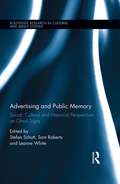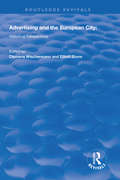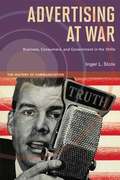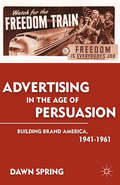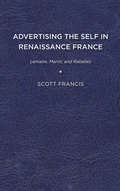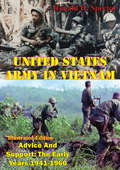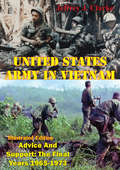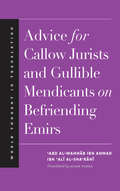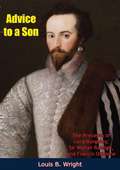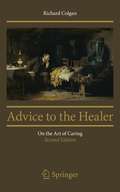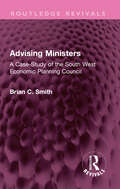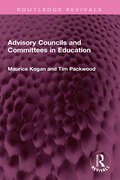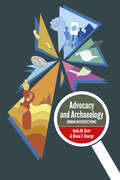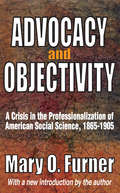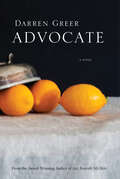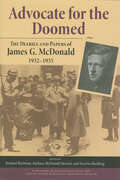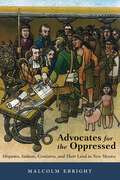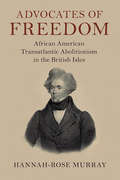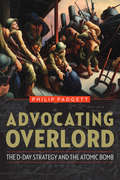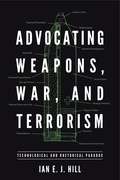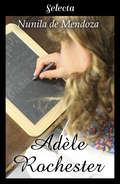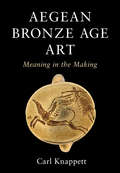- Table View
- List View
Advertising and Public Memory: Social, Cultural and Historical Perspectives on Ghost Signs (Routledge Research in Cultural and Media Studies)
by Sam Roberts Leanne White Stefan SchuttThis is the first scholarly collection to examine the social and cultural aspects on the worldwide interest in the faded remains of advertising signage (popularly known as ‘ghost signs’). Contributors to this volume examine the complex relationships between the signs and those who commissioned them, painted them, viewed them and view them today. Topics covered include cultural memory, urban change, modernity and belonging, local history and place-making, the crowd-sourced use of online mobile and social media to document and share digital artefacts, ‘retro’ design and the resurgence in interest in the handmade. The book is international and interdisciplinary, combining academic analysis and critical input from practitioners and researchers in areas such as cultural studies, destination marketing, heritage advertising, design, social history and commercial archaeology.
Advertising and the European City: Historical Perspectives (Routledge Revivals)
by Clemens Wischermann Elliott ShoreFirst published in 2000, this volume responds to the rise and spread of advertising throughout Europe and the world in the past one and a half centuries which is breathtaking in its scope and influence, now part of the way we think and live. Historians are only just beginning to understand this process, replacing outmoded theories of manipulation which focused on the advertiser with more sophisticated cultural explanations that centre on the way consumers filter and select messages creating new worlds of perception. The authors of this work find the origins and trace the development of this new world or perception in the modern city: London and Paris, the forerunners, and the cities and larger towns of France, Germany, Belgium and the Netherlands, where advertising created new urban perceptions, leading to new avenues of consumption and altered lifestyles. Advertising is viewed in this work as a new way of perceiving and organising the world of the city-dweller, a visual culture, a way of attaching meaning to things and to words, or rearranging the mental map of modern life.
Advertising at War: Business, Consumers, and Government in the 1940s
by Inger L StoleAdvertising at War challenges the notion that advertising disappeared as a political issue in the United States in 1938 with the passage of the Wheeler-Lea Amendment to the Federal Trade Commission Act, the result of more than a decade of campaigning to regulate the advertising industry. Inger L. Stole suggests that the war experience, even more than the legislative battles of the 1930s, defined the role of advertising in U.S. postwar political economy and the nation's cultural firmament. She argues that Washington and Madison Avenue were soon working in tandem with the creation of the Advertising Council in 1942, a joint effort established by the Office of War Information, the Association of National Advertisers, and the American Association of Advertising Agencies. Using archival sources, newspapers accounts, and trade publications, Stole demonstrates that the war elevated and magnified the seeming contradictions of advertising and allowed critics of these practices one final opportunity to corral and regulate the institution of advertising. Exploring how New Dealers and consumer advocates such as the Consumers Union battled the advertising industry, Advertising at War traces the debate over two basic policy questions: whether advertising should continue to be a tax-deductible business expense during the war, and whether the government should require effective standards and labeling for consumer products, which would render most advertising irrelevant. Ultimately the postwar climate of political intolerance and reverence for free enterprise quashed critical investigations into the advertising industry. While advertising could be criticized or lampooned, the institution itself became inviolable.
Advertising in the Age of Persuasion: Building Brand America 1941–1961
by D. SpringAdvertising in the Age of Persuasion documents and analyzes the implementation of the American strategy of consumerism during the 1940s and 1950s, and its ongoing ramifications. Beginning with World War II, and girded by the Cold War, American advertisers, brand name corporations, and representatives of the federal government institutionalized a system of consumer capitalism which they called free enterprise. In their system, government and business worked together to create consumer republics, democracies based on the mass consumption of brand name goods using advertising across all major media to sell products and distribute information. Many of the free enterprise evangelists believed it represented the fulfillment of America's god-ordained mission. They envisioned an American lead global consumer order supported by advertising based media where the brand took precedence over the corporation that owned it; and advertising, propaganda and public relations were considered the same thing. To support this system, they created a network and process for disseminating persuasive information that survives into the 21st Century.
Advertising the American Dream: Making Way for Modernity, 1920-1940
by Roland MarchandIt has become impossible to imagine our culture without advertising. But how and why did advertising become a determiner of our self-image? Advertising the American Dream looks carefully at the two decades when advertising discovered striking new ways to play on our anxieties and to promise solace for the masses.As American society became more urban, more complex, and more dominated by massive bureaucracies, the old American Dream seemed threatened. Advertisers may only have dimly perceived the profound transformations America was experiencing. However, the advertising they created is a wonderfully graphic record of the underlying assumptions and changing values in American culture. With extensive reference to the popular media—radio broadcasts, confession magazines, and tabloid newspapers—Professor Marchand describes how advertisers manipulated modern art and photography to promote an enduring "consumption ethic."
Advertising the Self in Renaissance France: Lemaire, Marot, and Rabelais (Early Modern Exchange)
by Scott FrancisAdvertising the Self in Renaissance France explores how authors and readers are represented in printed editions of three major literary figures: Jean Lemaire de Belges, Clément Marot, and François Rabelais. Print culture is marked by an anxiety of reception that became much more pronounced with increasingly anonymous and unpredictable readerships in the sixteenth century. To allay this anxiety, authors, as well as editors and printers, turned to self-fashioning in order to sell not only their books but also particular ways of reading. They advertised correct modes of reading as transformative experiences offered by selfless authors that would help the actual reader attain the image of the ideal reader held up by the text and paratext. Thus, authorial personae were constructed around the self-fashioning offered to readers, creating an interdependent relationship that anticipated modern advertising.Distributed for the University of Delaware Press
Advice Among Masters: The Ideal in Slave Management in the Old South (Contributions In Afro-american And African Studies #No. 51)
by James O. BreedenThis collection of documents on slavery is like no other: it portrays plantation slavery from the point of view of the masters. They are in this case those slaveholders who wrote on the ideal in slave manage¬ment for the southern agricultural press during the four decades pre¬ceding the Civil War. Slave management studies were a prominent and frequent feature of the South's farm journals. An extensive sampling of these studies is included here to make readily accessible an important source for the study of slavery.
Advice And Support: The Early Years 1941-1960 [Illustrated Edition]
by Ronald H. SpectorIncludes over 75 maps, photos and plans.The present volume describes the activities of the U.S. Army in Vietnam during World War II, military advice and assistance to the French government during the immediate post-war years, and the advisory program that developed after the Geneva Agreements of 1954. Its scope ranges from high-level policy decisions to low-echelon advisory operations in the field, presented against a background of relevant military and political developments. The author enjoyed access to the official records of the period and examined personal papers, interviews, other documentary sources, and miscellaneous published materials. Useful not only as a study of military assistance but as a view of the Army as an agent of national policy, this volume is a fitting introduction to the overall study of the conflict in Vietnam.
Advice And Support: The Final Years 1965-1973 [Illustrated Edition]
by Jeffrey J. ClarkeIncludes over 75 maps, photos and plans.In Advice and Support: The Final Years the author describes the U.S. Army advisory effort to the South Vietnamese armed forces during the period when the U.S. commitment in Southeast Asia was at its peak. The account encompasses a broad spectrum of activities at several levels, from the physically demanding work of the battalion advisers on the ground to the more sophisticated undertakings of our senior military officers at the highest echelons of the American military assistance command in Saigon. Among critical subjects treated are our command relationships with the South Vietnamese army, our politico-military efforts to help reform both the South Vietnamese military and government, and our implementation of the Vietnamization policy inaugurated in 1969. The result tells us much about the U.S. Army's role as an agent of national policy in a critical but often neglected arena, and constitutes a major contribution to our understanding of not only the events that occurred in Vietnam but also the decisions and actions that produced them.
Advice for Callow Jurists and Gullible Mendicants on Befriending Emirs
by Adam Sabra Abd al-Wahhab al-SharaniThis mirror for princes sheds light on the relationship between spiritual and political authority in early modern Egypt This guide to political behavior and expediency offers advice to Sufi shaykhs, or spiritual guides, on how to interact and negotiate with powerful secular officials, judges, and treasurers, or emirs. Translated into English for the first time, it is a unique account of the relationship between spiritual and political authority in late medieval / early modern Islamic society.
Advice to a Son: The Precepts of Lord Burghley, Sir Walter Raleigh, and Francis Osborne
by Louis B. Wright“Guides to conduct are common to all ages, for writers never cease to believe that the distillation of their wisdom will in some fashion improve the behavior of youth and provide useful instruction to their elders. The sixteenth century was a particularly didactic age and had more than its share of self-appointed instructors with faith in their missions.” So writes Louis B. Wright in his Introduction to Advice to a Son.This volume makes available three of the most famous sets of precepts. The manuals attributed to Lord Burghley and Sir Walter Raleigh and a treatise compiled by Francis Osborne are indicative of both the aspirations and the morals of the sixteenth and seventeenth centuries, and they provide an index to the social attitudes of the age.Immensely popular and influential, they were often reprinted, quoted from, and plagiarized. Some students of Shakespeare profess to see a parallel between Polonius advice to Laertes and Burghley’s practical counsel to his son Robert.The advice that these treatises offer is materialistic and even cynical, because the writers, moving in a political milieu, were realists who were attempting to provide instruction to their sons that would ensure success they would have cared not at all for the idealistic niceties. The distinction and position of Burghley and Raleigh may in part account for the popularity of their manuals in the seventeenth century, long after their deaths, but obviously both works possessed qualities congenial to the age, and readers approved of the way they mingled virtue and pragmatism.Of the three works, Dr. Wright comments, Osborne’s “must be regarded as a literary creation in addition to being a practical manual composed for the use of a particular person.”The student of English history will find this book a valuable addition to his library.
Advice to the Healer: On the Art of Caring
by Richard ColganThis book introduces the origins of important teachings that form the basis of medicine and related healing professions. Reinforcing the humanistic side of patient care, this book replicates the tips, anecdotes and aphorisms often related by mentors and educators to medical students, residents, and young physicians. This book provides numerous examples of best practices in the art of medicine, profiles of great healers throughout history and around the world, and stories sure to inspire any practicing healer, whether they are new to the calling or a seasoned veteran.
Advising Ministers: A Case-Study of the South West Economic Planning Council (Routledge Revivals)
by Brian C SmithFirst published in 1969, Advising Ministers is a general account of the arrangements for ‘advising Ministers’, based on a case-study, enabling the reader to judge the effectiveness of an advisory body in a particular case, which itself gained much publicity and in which hopes were high that results would be achieved. Mr. Smith’s conclusions are based on published material and informed, shrewd deduction to provide a valuable addition to the all too meagre case-study material on British administration. This book will be of interest to students of history, sociology, economics and political science.
Advisory Councils and Committees in Education (Routledge Revivals)
by Maurice Kogan Tim PackwoodFirst published in 1974, Advisory Councils and Committees in Education is an analytical account of the role of advisory councils and committees in creating and promulgating educational policies. The book reviews systematically the content of twenty-eight reports starting with the Hadow Report of 1926, in terms of developments in educational philosophy, government and administration, social policy and the economics of education. It also analyses the membership and working of the committees. The study is based on historical and organizational analysis. It is concerned not only with what the councils did but takes up the wider questions of the place of such councils and committees in educational government and their relevance for changing assumptions about other ways in which government is advised. This book will be of interest to students of education, pedagogy and public policy.
Advocacy and Archaeology: Urban Intersections
by Kelly M. Britt and Diane F. GeorgeArchaeologists have a history of being prime agents of change, particularly in advocating for protection and preservation of historical resources. As more social issues intersect with archaeology and historical sites, we see archaeologists and others continuing to advocate for not only historic resources, but for the larger social justice issues that threaten the communities in which these resources reside. Inspired by the idea of revolution and excitement about the ways archaeology is being used in social justice arenas, this volume seeks to visualize archaeology as part of a movement by redefining what archaeology is and does for the greater good.
Advocacy and Objectivity: A Crisis in the Professionalization of American Social Science, 1865-1905
by Mary FurnerThis award-winning book of the Frederick Jackson Turner Studies describes the early development of social science professions in the United States. Furner traces the academic process in economics, sociology, and political science. She devotes considerable attention to economics in the 1880s, when first-generation professionals wrestled with the enormously difficult social questions associated with industrialization. Controversies among economists reflected an endemic tension in social science between the necessity of being recognized as objective scientists and an intense desire to advocate reforms.Molded by internal conflicts and external pressures, social science gradually changed. In the 1890s economics was defined more narrowly around market concerns. Both reformers and students of social dynamics gravitated to the emerging discipline of sociology, while political science professionalized around the important new field of public administration. This division of social science into specialized disciplines was especially significant as progressivism opened paths to power and influence for social science experts.Professionalization profoundly altered the role and contribution of social scientists in American life. Since the late nineteenth century, professionals have exerted increasing control over complex economic and social processes, often performing services that they themselves have helped to make essential. Furner here seeks to discover how emerging groups of American social scientists envisioned their role what rights and responsibilities they claimed how they hoped to perform a vital social function as they fulfilled their own ambitions, and what restraints they recognized.
Advocate
by Darren GreerWhen Jacob is called back to Advocate, he is not only returning home again, something he knows he cannot really do; he is going to face his dying grandmother and the people of the town who turned on one of their own. Twenty years earlier, when his uncle David came home, it was to die. The response in Advocate was typical of most towns, large and small, in 1984: when his disease became known, Jacob, his grandmother, his mother, and his aunt, were shunned, turned out from school and their jobs, out of fear of an until-then unknown virus. Like To Kill a Mockingbird, a novel beloved of one of the main characters, Advocate is elegiac, written by a first-rate author, about overcoming ignorance and prejudice. With wit and emotional depth, Greer describes the formation of one boy’s social conscience and takes us to a resolution that is truly satisfying.
Advocate
by Darren GreerWhen Jacob is called back to Advocate, he is not only returning home again, something he knows he cannot really do; he is going to face his dying grandmother and the people of the town who turned on one of their own. Twenty years earlier, when his uncle David came home, it was to die. The response in Advocate was typical of most towns, large and small, in 1984: when his disease became known, Jacob, his grandmother, his mother, and his aunt, were shunned, turned out from school and their jobs, out of fear of an until-then unknown virus. Like To Kill a Mockingbird, a novel beloved of one of the main characters, Advocate is elegiac, written by a first-rate author, about overcoming ignorance and prejudice. With wit and emotional depth, Greer describes the formation of one boy’s social conscience and takes us to a resolution that is truly satisfying.
Advocate for the Doomed: The Diaries and Papers of James G. McDonald, 1932–1935
by James G. McDonald“[Chronicles] the efforts of this principled and persistent man to save Jews and others from the horrors of Nazism.” —Foreign AffairsThe private diary of James G. McDonald (1886–1964) offers a unique and hitherto unknown source on the early history of the Nazi regime and the Roosevelt administration’s reactions to Nazi persecution of German Jews. Considered for the post of US ambassador to Germany at the start of FDR’s presidency, McDonald traveled to Germany in 1932 and met with Hitler soon after the Nazis came to power. Fearing Nazi intentions to remove or destroy Jews in Germany, in 1933 he became League of Nations High Commissioner for Refugees and sought aid from the international community to resettle outside the Reich Jews and others persecuted there. In late 1935 he resigned in protest at the lack of support for his work.This is the eagerly awaited first of a projected three-volume work that will significantly revise the ways that scholars and the world view the antecedents of the Holocaust, the Shoah itself, and its aftermath.“A compelling look at one man’s efforts to do something about a looming catastrophe. At times the book is inspiring—McDonald’s prescience and energy are simply amazing. But because we know what is soon to happen to Europe’s Jews, we share his frustration that no one seems to be listening. We feel what it was to be an advocate for the doomed.” —The Wall Street Journal“The diaries show that McDonald believed as early as 1933 that the Nazis were considering the mass killing of Europe’s Jews.” —The New York Times
Advocates for the Oppressed: Hispanos, Indians, Genízaros, and Their Land in New Mexico
by Malcolm EbrightStruggles over land and water have determined much of New Mexico&’s long history. The outcome of such disputes, especially in colonial times, often depended on which party had a strong advocate to argue a case before a local tribunal or on appeal. This book is partly about the advocates who represented the parties to these disputes, but it is most of all about the Hispanos, Indians, and Genízaros (Hispanicized nomadic Indians) themselves and the land they lived on and fought for.Having written about Hispano land grants and Pueblo Indian grants separately, Malcolm Ebright now brings these narratives together for the first time, reconnecting them and resurrecting lost histories. He emphasizes the success that advocates for Indians, Genízaros, and Hispanos have had in achieving justice for marginalized people through the return of lost lands and by reestablishing the right to use those lands for traditional purposes.
Advocates of Freedom: African American Transatlantic Abolitionism in the British Isles (Slaveries since Emancipation)
by Hannah-Rose MurrayDuring the nineteenth century and especially after the Civil War, scores of black abolitionists like Frederick Douglass, Moses Roper and Ellen Craft travelled to England, Ireland, Scotland, and parts of rural Wales to educate the public on slavery. By sharing their oratorical, visual, and literary testimony to transatlantic audiences, African American activists galvanised the antislavery movement, which had severe consequences for former slaveholders, pro-slavery defenders, white racists, and ignorant publics. Their journeys highlighted not only their death-defying escapes from bondage but also their desire to speak out against slavery and white supremacy on foreign soil. Hannah-Rose Murray explores the radical transatlantic journeys formerly enslaved individuals made to the British Isles, and what light they shed on our understanding of the abolitionist movement. She uncovers the reasons why activists visited certain locations, how they adapted to the local political and social climate, and what impact their activism had on British society.
Advocating Overlord: The D-Day Strategy and the Atomic Bomb
by Philip Padgett“Well there it is. It won’t work, but you must bloody well make it,” said the chief of Britain’s military leaders, when he gave orders to begin planning for what became known as Operation Overlord. While many view D-Day as one of the most successful operations of World War II, most aren’t aware of the intensive year of planning and political tension between the Allies that preceded the amphibious military landing on June 6, 1944. This intriguing history reveals how President Franklin D. Roosevelt, while on a fishing trip in the middle of World War II, altered his attitude toward Winston Churchill and became an advocate for Operation Overlord. Philip Padgett challenges the known narrative of this watershed moment in history and illuminates the diplomatic link between Normandy and the atomic bomb. He shows how the Allies came to agree on a liberation strategy that began with D-Day—and the difficult forging of British and American scientific cooperation that produced the atomic bomb. At its core this story is about how a new generation of leaders found the courage to step beyond national biases in a truly allied endeavor to carry out one of history’s most successful military operations.
Advocating Weapons, War, and Terrorism: Technological and Rhetorical Paradox (RSA Series in Transdisciplinary Rhetoric #9)
by Ian E. HillTechnē’s Paradox—a frequent theme in science fiction—is the commonplace belief that technology has both the potential to annihilate humanity and to preserve it. Advocating Weapons, War, and Terrorism looks at how this paradox applies to some of the most dangerous of technologies: population bombs, dynamite bombs, chemical weapons, nuclear weapons, and improvised explosive devices.Hill’s study analyzes the rhetoric used to promote such weapons in the nineteenth and twentieth centuries. By examining Thomas R. Malthus’s Essay on the Principle of Population, the courtroom address of accused Haymarket bomber August Spies, the army textbook Chemical Warfare by Major General Amos A. Fries and Clarence J. West, the life and letters of Manhattan Project physicist Leo Szilard, and the writings of Ted “Unabomber” Kaczynski, Hill shows how contemporary societies are equipped with abundant rhetorical means to describe and debate the extreme capacities of weapons to both destroy and protect. The book takes a middle-way approach between language and materialism that combines traditional rhetorical criticism of texts with analyses of the persuasive force of weapons themselves, as objects, irrespective of human intervention. Advocating Weapons, War, and Terrorism is the first study of its kind, revealing how the combination of weapons and rhetoric facilitated the magnitude of killing in the nineteenth and twentieth centuries, and illuminating how humanity understands and acts upon its propensity for violence. This book will be invaluable for scholars of rhetoric, scholars of science and technology, and the study of warfare.
Adèle Rochester
by Nunila de MendozaEn esta novela, la autora nos cuenta la historia de Adèle Rochester, la que fuera hija ilegítima de Edward Rochester, el inolvidable protagonista de Jane Eyre: su periplo a en la búsqueda de su madre, la decepción amorosa y el romance apasionado con Marcos Hassin, un librepensador y un hombre tan opuesto a ella que le resulta irresistible. La continuación de la clásica e inmortal novela Jane Eyre. Ahora Adèle es la niña que recoge Edward Rochester por lástima cuando una bailarina francesa que fuera su amante, le dice que es su hija. Aunque Rochester duda de su paternidad, la acoge en su hogar, y con los cuidados de Jane Eyre se convierte en una mujer noble, sencilla, inteligente y bondadosa. Antes de morir, Edward Rochester la adopta como hija legítima. Pero su dinero y gran belleza se convierten en la maldición de su vida. Después de una gran decepción amorosa, decide viajar a Francia y buscar a su verdadera madre para que esta le confíe el secreto de su existencia. En ese viaje de autodescubrimiento se enamora de Marcos Hassin, un librepensador anárquico, de carácter tan opuesto a Adèle como salvaje, que hace inevitable la atracción. Luchas internas, misterios, muchas aventuras y una gran historia de amor.
Aegean Bronze Age Art: Meaning in the Making
by Carl KnappettHow do we interpret ancient art created before written texts? Scholars usually put ancient art into conversation with ancient texts in order to interpret its meaning. But for earlier periods without texts, such as in the Bronze Age Aegean, this method is redundant. Using cutting-edge theory from art history, archaeology, and anthropology, Carl Knappett offers a new approach to this problem by identifying distinct actions - such as modelling, combining, and imprinting - whereby meaning is scaffolded through the materials themselves. By showing how these actions work in the context of specific bodies of material, Knappett brings to life the fascinating art of Minoan Crete and surrounding areas in novel ways. With a special focus on how creativity manifests itself in these processes, he makes an argument for not just how creativity emerges through specific material engagements but also why creativity might be especially valued at particular moments.
